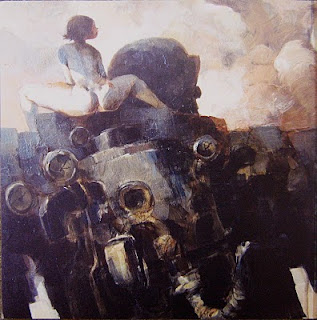Nobody talks much about Robert Riggs anymore, but he was once one of the nation's most highly regarded illustrators.
As Walt Reed wrote, "Robert Riggs was awarded the Gold Medal for Excellence by the New York Art Directors Club for ten consecutive years and received many additional awards." He was elected to the Society of Illustrators' Hall of Fame. His work is in the permanent collections of the Metropolitan Museum of Art in New York, the Philadelphia Museum of Fine Arts and the U.S. Library of Congress.
What made Riggs so special? If you went through a checklist of factors that normally make an illustrator stand out, Riggs seemed to have none of them. His work was not flashy or innovative or glamorous. He had no special talent for anatomy or facial expressions. His compositions and colors weren't stylish or bold. If anything, he favored basic, symmetrical compositions with conventional color schemes:
 |
| Note how frequently Riggs plants his subject right smack dab in the middle of his canvas. |
Furthermore, his subject matter was hardly topical or crowd-pleasing. No one would describe his work as romantic or witty or trendy-- no pretty girls, no heart-warming family scenes, no attractive couples in passionate clinches. And Riggs didn't try to show off with a lot of details and frills. To the contrary, he simplified and stripped away unnecessary detail.
For me, the special appeal of Riggs' work is in its distinctive weight. He imbued every subject with a great feeling of solidity and substance-- what Reed calls "monumental" compositions. Riggs' figures in the following picture are made of the same granite as the mountains behind them.
Riggs didn't follow the recipe for popular illustrations of his day. He viewed the world in a powerful, muscular way and conveyed his vision as honestly as he could. That was enough to capture audiences and the respect of his peers.
Riggs had very few imitators, perhaps because other illustrators just didn't see the world through his eyes.

































